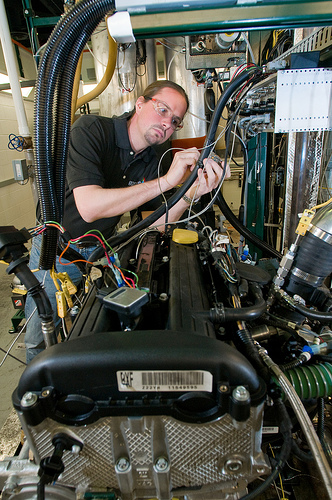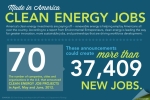#LabChat Recap: Innovations Driving More Efficient Vehicles
The #LabChat on Dec. 13 sparked an engaging discussion about technologies that are improving vehicle fuel economy. Three researchers answered questions about advanced combustion, lightweighting and hybridization. Here is an overview of some of the conversations.
Storified by Energy Department ·
Fri, Dec 21 2012 08:19:22
We kicked off the #LabChat with introductions from all the
researchers. Each researcher focuses on a different vehicle
technology that is expected to make great strides in improving vehicle
mileage.
Welcome to #LabChat: Innovations Driving More Efficient Vehicles
Energy Department technology manager Gurpreet Singh leads
the Advanced Combustion Engine Technologies team, which focuses on improving
combustion engines and emissions control technologies that will make vehicles
drive farther on less fuel.
Dean Paxton is a Pacific Northwest National Laboratory
researcher who focuses on advances in lightweight vehicle materials. As Paxton
points out below, this is important because lighter vehicles will help reduce
the amount of fuel vehicles use.
@argonne - my research area is lightweight materials, a 10% decrease in vehicle wt will increase fuel economy by 6-8% #labchat
Argonne
National Laboratory researcher Eric Rask explores new technological
developments in electric and other advanced vehicles.
Before we get into the specific technologies that are
improving vehicle fuel economy, it is important to understand how vehicles have
changed over time as well as what the Energy Department's National Laboratories
are doing to make vehicles more efficient today than the ones in the
past. This video from Argonne National Lab provides a nice overview of why
vehicle advancements are important.
One of the first questions focused on new information
technology developments that could help consumers save money on fuel
costs.
IT increases fuel efficiency by leveraging smart-phones to find optimal route. #Opendata from cities also helps avoid traffic #LabChat
IT reduces pollution. Mechanics use on-board diagnostics to measure/control vehicle emissions on all US cars since 1996 #LabChat
#Opendata from vehicles, like OBD, tells owners when preventative maintenance is needed, which saves fuel #LabChat http://go.usa.gov/gmmG
While we shared a handful of examples on ways open data can
help improve vehicle fuel efficiency, we are looking for innovators to share
their best business plans, app ideas and product designs that use open vehicle
data to help vehicle owners save fuel, save money and stay safe as part of the Apps for
Vehicles Challenge.
Many of the people joining #LabChat had questions about the
potential of incorporating lightweight materials in vehicles. But did you know
that many of the cars on the road today already use some lightweight
materials?
@ENERGY - All cars made today use all or some LW materials, such as adv high-strength steel, aluminum, magnesium, & composites #labchat
However, we face many challenges in replacing steel alloys
with advanced, lightweight materials. Lightweight materials are more
complicated to join to other materials, more difficult to model, more
challenging to recycle than conventional iron and steel alloys, and of course,
more expensive.
@frannywhite @ENERGY- will depend on the matl, but LWM are more expensive to make into parts than heavier materials will replace #labchat
@frannywhite @ENERGY-typical will be $3-$10 more for LWM for every lb of heavier material saved, but also depends on gas prices #labchat
While lightweight materials might be more expensive, they do
make fuel-efficient alternative power systems -- like hybrids, plug-in hybrids
and all-electric vehicles -- possible. Lighter
materials also allow cars to carry advanced emission control systems,
safety devices and electronic systems without increasing their weight.
@sciwriter - lw materials that reduce wt of vehicles can make many alternative propulsion/power systems more viable #labchat
When it comes to hybridization, our audience skipped the easy questions and went straight to the hard ones. But
for everyone else, hybridization is when a vehicle has both an internal
combustion engine and an electric motor that uses energy stored in a battery.
Hybrids are some of the most efficient vehicles on the road because the second
power source (the battery) is used instead of fuel, helping increase a
vehicle's miles per gallon.
Now that we know the basics of hybridization, we can explore
the technology in more detail. What is microhybridization and what
are the cost considerations?
@sciencewriter, @arthurhcyip: I consider micro-hybrid primarily engine stop-start. We'll see about the economics. Available soon. #LabChat
As Rask explains, micro hybrids -- also called stop-start
hybrids -- include a small electric motor that allows the vehicle to
shut off the engine when the vehicle stops, such as at traffic lights or
in stop-and-go traffic.
When it comes to cost, micro hybrids could be less expensive
than mild or full hybrids because they have a smaller battery. But micro
hybrids also have lower fuel economy than mild or full hybrids because micro
hybrids can't use only the electricity stored in the battery to power the
vehicle.
With full
hybrids -- which have larger batteries and electric motors that enable
them to drive using just the electric power for short distances -- there are a
couple different ways to combine the power from the electric motor and the
combustion engine. Parallel hybrids use both the electric motor and the engine
to turn the wheels of the vehicle, while series hybrids only use the electric
motor to move the wheels. As Rask points out, the majority of hybrids on the
market combine both parallel and series technology.
.@TScott0: The majority of current hybrids are actually power-split, which offers both series and parallel functionality. #LabChat
Power-split technology works by hooking
the combustion engine, generator and electric motor together. This allows
the vehicle to operate like a parallel hybrid -- the electric motor, combustion
engine or both can power the vehicle -- or a series hybrid -- the combustion
engine can be used to independently power the vehicle's accessories.
The third focus of the #LabChat was on advanced
combustion -- which is finding new ways to combine and ignite air
and fuel more efficiently. This picture shows an Argonne researcher getting
real-time feedback on advanced combustion technologies.
With technology improvements, there is always a question
about the return on investment (ROI), and with vehicle technology, it is no
different.
Depends on the tech and efficiency improvement. For ex, in heavy duty engine tech research, we have seen ROI greater than 50:1 #labchat
When it comes to the investment in new commercial engine
technology, Energy Department-sponsored research and development has helped
engine manufactures improve diesel engine efficiency by 4-5
percent since 2002, saving more than 2.4 billion gallons of
diesel fuel.
@PNNLNews #LabChat what's the future of variable displacement engines with efficiency?
Another way to save fuel is to have a smaller engine in the
vehicle. Or you can have an engine that sometimes acts like a smaller engine by shutting off some of the cylinders when not in use -- this is
called cylinder
deactivation or cylinder cut-out. Cylinder deactivation is not a
new technology -- the first experiments with cylinder deactivation happened
during World War II and later the technology was included in a few vehicle
models in the second half of the 20th century -- and automakers are increasingly
interested in this technology to meet fuel economy goals.
We expect to see more engines w/variable displacement (cylinder cut-out) in the future to improve fuel economy in urban driving #labchat
Cylinder deactivation allows an 8-cylinder engine to act as if
it is a 6-cylinder engine to improve fuel economy. During normal usage -- like
accelerating and going uphill -- the engine uses all of its cylinders. But
during low-load conditions -- like cruising on the highway and low-speed urban
driving -- some of the engine's cylinders turn off. This technology isn't just
for gasoline-powered engines. As Singh suggests, it can also be incorporated
with diesel technology.
Yes! RT @MPGomatic: @ENERGY Wondering: could cylinder deactivation be used with clean diesel applications? #labchat
@ENERGY - in LW mtls, many mtls have been demonstrated to meet functional reqts for automotive, but the mtl costs are too high #labchat
Getting to a reasonable payback period for customer acceptance is a challenge for advanced technologies #labchat
![]()












